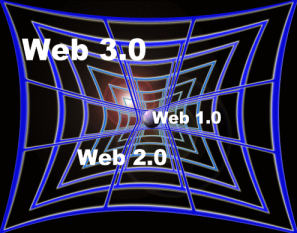 For some reason, I haven’t heard much about the next generation of the Internet (Web 3.0) lately, which probably means it isn’t happening as fast as everyone predicted. It’s already a couple of years behind schedule from my perspective. I suspect the real challenge is not the semantic web technology, but new attractive business models from smart entrepreneurs.
For some reason, I haven’t heard much about the next generation of the Internet (Web 3.0) lately, which probably means it isn’t happening as fast as everyone predicted. It’s already a couple of years behind schedule from my perspective. I suspect the real challenge is not the semantic web technology, but new attractive business models from smart entrepreneurs.
After some work, I’m still convinced that much of the Web 3.0 buzz has always been hype, but things are changing on the Internet, and bits and pieces of Web 3.0 are appearing. According to Michael Tasner, in his book “Marketing in the Moment: The Practical Guide to Using Web 3.0 Marketing to Reach Your Customers First,” here are the five key components to watch:
-
Micro-blogging. This is the ability to share your thoughts with a minimum number of characters. People are busy, with limited time, so why not get right to the point of the story, in 140 characters or fewer? Examples include Twitter, Plurk, and Jaiku.
-
Virtual reality worlds. These are places users visit to interact with others from around the world in a 3-D setting. Meetings are conducted in these spaces, and trade shows are being replaced with virtual reality shows. Examples include Second Life and Funsites.
-
Extended personalization. Web 3.0 will allow visitors to create an ever more personal experience. They are starting to expect their name to appear at the top of Web sites, personalized e-mails, and even advanced checkout options that suit their habits. Examples include SendOutCards, Google, and Amazon.
-
Mobile smart phones. There are billions of cell-phone users throughout the world, a number much larger than those who use PCs. Consumers are surfing the Web, purchasing products, and becoming instant photo journalists from their iPhone and Blackberry.
-
Real time on-demand collaboration. Users can now interact in real time on documents, collaboration, including making changes. Many software-as-a-service (SaaS) applications now allow on-demand collaboration. Examples include Google Docs, Salesforce.com, Slideshare.net, and Box.net.
According to Tasner, who is a marketing guru, business models and marketing in the Web 3.0 environment will need the most dramatic changes to be consistent with the new culture and technology. These include:
- Adapting to mobile, the largest and fastest-growing Web 3.0 trend. Marketing messages have to be adapted and directed to the smart phones, which all have web access, e-mail, video, texting, as well as voice.
- Accommodate the resistance to sharing all information with everyone. People are more and more worried about personal privacy and identity theft. This is driving a trend towards micro-community sites and smaller, more specialized social sites. Marketers need an effective presence on these sites for credibility and trust.
- Facilitate virtual communication versus face-to-face meetings. It’s too expensive to fly across country for marketing trade shows and big sales meetings. Virtual trade shows, GoToMeeting, and WebEx are attracting new customers like crazy.
- People on the Web now include everyone. Twelve-year-olds are running million-dollar-social networks, your grandma is tweeting, and your long-lost cousin runs a popular tribe on Second Life. This trend is escalating, and will not change.

